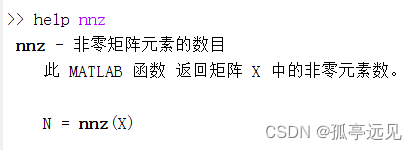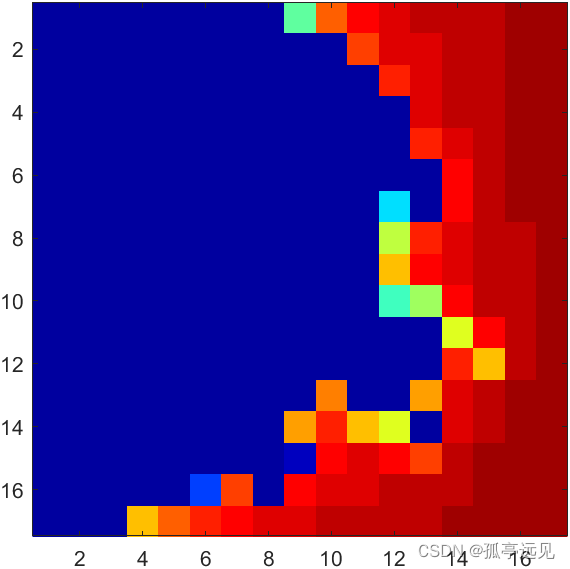MATLAB编程实践12、13
生命游戏
游戏的宇宙是无限可扩展的二维矩形网格,群体是那些标注为存活的网格的集合。群体可以依照称为代的离散时间步距进化。在每一步中,每个网格的命运由它周围最近的8个网格邻居的活度决定,规则如下:
如果一个存活的网格有两个(或三个)存活的邻居,或者一个死亡的网格周围有三个存活的邻居,则它在下一步中也是存活的。
滑翔机
滑翔机五网格群体初始结构,每一步进化过程中,都有两个网格死亡,并有两个新网格出生。
访问周围网格,并计算存活数目
n = size(X,1); p = [1 1:n-1]; q = [2:n n]; % Count how many of the eight neighbors are alive. Y = X(:,p) + X(:,q) + X(p,:) + X(q,:) + ... X(p,p) + X(q,q) + X(p,q) + X(q,p); % A live cell with two live neighbors, or any cell with % three live neigbhors, is alive at the next step. X = (X & (Y == 2)) | (Y == 3); [loop,buttons] = query_buttons(buttons,pop); t = t + 1;
产生随机的初始群体
% Generate a random initial population X = sparse(50,50); X(21:30,21:30) = (rand(10,10) > .75); p0 = nnz(X);
循环100代
% Loop over 100 generations. for t = 1:100 spy(X) title(num2str(t)) drawnow % Whether cells stay alive, die, or generate new cells depends % upon how many of their eight possible neighbors are alive. % Index vectors increase or decrease the centered index by one. n = size(X,1); p = [1 1:n-1]; q = [2:n n]; % Count how many of the eight neighbors are alive. Y = X(:,p) + X(:,q) + X(p,:) + X(q,:) + ... X(p,p) + X(q,q) + X(p,q) + X(q,p); % A live cell with two live neighbors, or any cell with % three live neigbhors, is alive at the next step. X = (X & (Y == 2)) | (Y == 3); end p100 = nnz(X); fprintf('%5d %5d %8.3f\n',p0,p100,p100/p0)
循环
function lifex(varargin)
lex = open_lex('lexicon.txt');
pop = population(lex,varargin{:});
repeat = true;
while repeat
% Place the initial population in the universe, X.
[lex,pop] = read_lexicon(lex,pop);
X = populate(pop);
[plothandle,buttons] = initial_plot(size(X),pop);
title(pop.name)
t = 0;
loop = true;
while loop
% Expand the universe if necessary to avoid the boundary.
X = expand(X,pop);
% Update the plot.
[i,j] = find(X);
set(plothandle,'xdata',j,'ydata',i);
caption(t,nnz(X))
drawnow
% Whether cells stay alive, die, or generate new cells depends
% upon how many of their eight possible neighbors are alive.
% Index vectors increase or decrease the centered index by one.
n = size(X,1);
p = [1 1:n-1];
q = [2:n n];
% Count how many of the eight neighbors are alive.
Y = X(:,p) + X(:,q) + X(p,:) + X(q,:) + ...
X(p,p) + X(q,q) + X(p,q) + X(q,p);
% A live cell with two live neighbors, or any cell with
% three live neigbhors, is alive at the next step.
X = (X & (Y == 2)) | (Y == 3);
[loop,buttons] = query_buttons(buttons,pop);
t = t + 1;
end
[repeat,pop] = what_next(buttons,lex,pop);
end
fclose(lex.fid);
set(buttons(1:6),'vis','off')
set(buttons(7),'value',0,'string','close','call','close(gcf)')
% ------------------------
function lex = open_lex(filename)
% lex = file_open(filename)
% lex.fid = file identifier
% lex.len = number of entries
% lex.index = index of current entry
lex.fid = fopen(filename);
if lex.fid < 3
error(['Cannot open "' filename '"'])
end
% Count number of usable entries,
lex.index = 0;
lex.len = 0;
while ~feof(lex.fid)
% Look for a line with two colons, ':name:'.
line = fgetl(lex.fid);
if sum(line == ':') >= 2
% name = line(2:find(line(2:end) == ':',1));
% Look for an empty line or a line starting with a tab.
tab = char(9);
task = [tab '*'];
tdot = [tab '.'];
while ~feof(lex.fid)
line = fgetl(lex.fid);
if isempty(line)
break
elseif strncmp(line(1:2),task,2) || strncmp(line(1:2),tdot,2)
lex.len = lex.len + 1;
% fprintf('%d: %s\n',lex.len,name)
break
end
end
end
end
frewind(lex.fid);
% ------------------------
function pop = population(varargin)
% pop = population(varargin)
% pop.index = index within lexicon of population
% pop.name = name of population
% pop.all = logical flag for slide show of populations
% pop.b = border width, default = 20
% pop.S = sparse matrix representation of population
lex = varargin{1};
pop.index = 0;
pop.name = ' ';
pop.all = false;
pop.b = 20;
pop.S = [];
if nargin < 2
pop.index = ceil(rand*lex.len);
elseif ischar(varargin{2}) && isequal(varargin{2},'all')
pop.all = true;
pop.b = 10;
elseif ischar(varargin{2})
pop.name = varargin{2};
pop.index = -1;
elseif min(size(varargin{2})) > 1
pop.S = sparse(varargin{2});
pop.name = sprintf('my %d-by-%d matrix',size(pop.S));
else
pop.index = varargin{2};
end
if nargin == 3
pop.b = varargin{3};
end
% ------------------------
function [lex,pop] = read_lexicon(lex,pop)
% [lex,pop] = read_lexicon(lex,pop)
% Update lex and pop to new population
if pop.all || pop.index > lex.len
pop.index = mod(pop.index,lex.len)+1;
end
if pop.index < lex.index
frewind(lex.fid)
lex.index = 0;
end
while lex.index ~= pop.index
% Look for a line with two colons, ':name:'.
line = fgetl(lex.fid);
if sum(line == ':') >= 2
name = line(2:find(line(2:end) == ':',1));
% Look for an empty line or a line starting with a tab.
tab = char(9);
task = [tab '*'];
tdot = [tab '.'];
while ~feof(lex.fid) && lex.index <= lex.len
line = fgetl(lex.fid);
if isempty(line)
break
elseif strncmp(line(1:2),task,2) || strncmp(line(1:2),tdot,2)
lex.index = lex.index + 1;
if lex.index == pop.index || ...
strncmpi(name,pop.name,length(pop.name))
pop.index = lex.index;
if pop.all
pop.name = [name ', index = ' int2str(pop.index)];
else
pop.name = name;
end
% Form sparse matrix by rows from '.' and '*'.
S = sparse(0,0);
m = 0;
while ~isempty(line) && (line(1)==tab)
row = sparse(line(2:end) == '*');
m = m+1;
n = length(row);
S(m,n) = 0;
S(m,1:n) = row;
line = fgetl(lex.fid);
end
pop.S = S;
elseif lex.index == lex.len
error('Population name is not in lexicon.')
end
break
end
end
end
end
% ------------------------
function [plothandle,buttons] = initial_plot(sizex,pop)
% [plothandle,buttons] = initial_plot(size(X),pop)
% plothandle = handle to customized "spy" plot
% buttons = array of handles to toggle buttons
clf
shg
m = max(sizex);
ms = max(10-ceil(m/10),2);
plothandle = plot(0,0,'o','markersize',ms,'markerfacecolor','blue');
set(gca,'xlim',[0.5 m+0.5],'ylim',[0.5 m+0.5],'ydir','rev', ...
'xtick',[],'ytick',[],'plotboxaspectratio',[m+2 m+2 1])
buttons = zeros(7,1);
bstrings = {'step','slow','fast','redo','next','random','quit'};
for k = 1:7
buttons(k) = uicontrol('style','toggle','units','normal', ...
'position',[.10+.12*(k-1) .005 .10 .045],'string',bstrings{k});
end
set(buttons(1),'userdata',0);
if pop.all, set(buttons(1:6),'vis','off'), end
% ------------------------
function X = populate(pop)
% X = populate(pop);
% X = sparse matrix universe with centered initial population
[p,q] = size(pop.S);
n = max(p,q) + 2*pop.b;
X = sparse(n,n);
i = floor((n-p)/2)+(1:p);
j = floor((n-q)/2)+(1:q);
X(i,j) = pop.S;
% ------------------------
function X = expand(X,pop)
% X = expand(X);
% Expand size if necessary to keep zeros around the boundary.
% Border width b avoids doing this every time step.
n = size(X,1);
b = max(pop.b,1);
if any(X(:,n-1) ~= 0) || any(X(n-1,:) ~= 0)
X = [X sparse(n,b); sparse(b,n+b)];
n = n + b;
end
if any(X(2,:) ~= 0) || any(X(:,2) ~= 0)
X = [sparse(b,n+b); sparse(n,b) X];
xlim = get(gca,'xlim')+b;
ylim = get(gca,'ylim')+b;
set(gca,'xlim',xlim,'ylim',ylim)
end
% ------------------------
function [loop,buttons] = query_buttons(buttons,pop)
% [loop,buttons] = query_buttons(buttons);
% loop = true: continue time stepping
% loop = false: restart
if pop.all
pause(1)
loop = false;
else
bv = cell2mat(get(buttons,'value'));
bk = get(buttons(1),'userdata');
if bk == 0 || sum(bv==1) ~= 1
while all(bv == 0)
drawnow
bv = cell2mat(get(buttons,'value'));
end
if sum(bv==1) > 1
bv(bk) = 0;
end
bk = find(bv == 1);
end
set(buttons([1:bk-1 bk+1:7]),'value',0)
switch bk
case 1 % step
set(buttons(1),'value',0);
bk = 0;
loop = true;
case 2 % slow
pause(.5)
loop = true;
case 3 % fast
pause(.05)
loop = true;
otherwise, loop = false;
end
% Remember button number
set(buttons(1),'userdata',bk);
end
% ------------------------
function [repeat,pop] = what_next(buttons,lex,pop)
% [next,pop] = what_next(buttons,lex,pop);
% repeat = true: start with a new population
% repeat = false: exit
bv = cell2mat(get(buttons,'value'));
bk = find(bv == 1);
set(buttons,'value',0)
repeat = true;
if ~isempty(bk)
switch bk
case 4 % redo
pop.index = lex.index;
case 5 % next
pop.index = mod(lex.index,lex.len)+1;
case 6 % random
pop.index = ceil(rand*lex.len);
case 7 % quit
repeat = false;
end
end
% ------------------------
function caption(t,nnz)
% caption(t,nnz(X))
% Print time step count and population size on the x-label.
s = sprintf('t=%3d, pop=%3d',t,nnz);
fs = get(0,'defaulttextfontsize')+2;
xlabel(s,'fontname','courier','fontsize',fs);
曼德勃罗集
曼德勃罗集是一个包含z0值的复平面区域,其轨迹定义为
z0=0.25-0.54i z=0 z=z^2+z0
数组运算
%% Define the region.定义复平面域的分割方式
x = 0: 0.05: 0.8;
y = x';
%% Create the two-dimensional complex grid using Tony's indexing trick.
n = length(x);
e = ones(n,1);
z0 = x(e,:) + i*y(:,e);
%% Or, do the same thing with meshgrid.
[X,Y] = meshgrid(x,y);
z0 = X + i*Y;
%% Initialize the iterates and counts arrays.
z = zeros(n,n);
c = zeros(n,n);
%% Here is the Mandelbrot iteration.
depth = 32;
for k = 1:depth %循环次数
z = z.^3 + z0;
c(abs(z) < 2) = k;
end
%% Create an image from the counts.
c %直接显示矩阵c
image(c)
axis image
%% Colors
colormap(flipud(jet(depth)))





